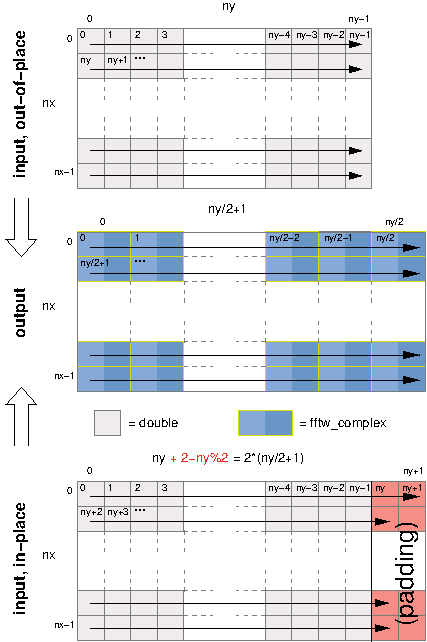
Next: More DFTs of Real Data, Previous: One-Dimensional DFTs of Real Data, Up: Tutorial [Contents][Index]
Multi-dimensional DFTs of real data use the following planner routines:
fftw_plan fftw_plan_dft_r2c_2d(int n0, int n1,
double *in, fftw_complex *out,
unsigned flags);
fftw_plan fftw_plan_dft_r2c_3d(int n0, int n1, int n2,
double *in, fftw_complex *out,
unsigned flags);
fftw_plan fftw_plan_dft_r2c(int rank, const int *n,
double *in, fftw_complex *out,
unsigned flags);
as well as the corresponding c2r routines with the input/output
types swapped. These routines work similarly to their complex
analogues, except for the fact that here the complex output array is cut
roughly in half and the real array requires padding for in-place
transforms (as in 1d, above).
As before, n is the logical size of the array, and the
consequences of this on the the format of the complex arrays deserve
careful attention.
Suppose that the real data has dimensions n0 × n1 × n2 × … × nd-1 (in row-major order).
Then, after an r2c transform, the output is an n0 × n1 × n2 × … × (nd-1/2 + 1) array of
fftw_complex values in row-major order, corresponding to slightly
over half of the output of the corresponding complex DFT. (The division
is rounded down.) The ordering of the data is otherwise exactly the
same as in the complex-DFT case.
For out-of-place transforms, this is the end of the story: the real data is stored as a row-major array of size n0 × n1 × n2 × … × nd-1 and the complex data is stored as a row-major array of size n0 × n1 × n2 × … × (nd-1/2 + 1).
For in-place transforms, however, extra padding of the real-data array
is necessary because the complex array is larger than the real array,
and the two arrays share the same memory locations. Thus, for
in-place transforms, the final dimension of the real-data array must
be padded with extra values to accommodate the size of the complex
data—two values if the last dimension is even and one if it is odd.
That is, the last dimension of the real data must physically contain
2 * (nd-1/2+1)double values (exactly enough to hold the complex data).
This physical array size does not, however, change the logical
array size—only
nd-1values are actually stored in the last dimension, and
nd-1is the last dimension passed to the plan-creation routine.
For example, consider the transform of a two-dimensional real array of
size n0 by n1. The output of the r2c transform is a
two-dimensional complex array of size n0 by n1/2+1, where
the y dimension has been cut nearly in half because of
redundancies in the output. Because fftw_complex is twice the
size of double, the output array is slightly bigger than the
input array. Thus, if we want to compute the transform in place, we
must pad the input array so that it is of size n0 by
2*(n1/2+1). If n1 is even, then there are two padding
elements at the end of each row (which need not be initialized, as they
are only used for output).
The following illustration depicts the input and output arrays just
described, for both the out-of-place and in-place transforms (with the
arrows indicating consecutive memory locations):

These transforms are unnormalized, so an r2c followed by a c2r transform (or vice versa) will result in the original data scaled by the number of real data elements—that is, the product of the (logical) dimensions of the real data.
(Because the last dimension is treated specially, if it is equal to
1 the transform is not equivalent to a lower-dimensional
r2c/c2r transform. In that case, the last complex dimension also has
size 1 (=1/2+1), and no advantage is gained over the
complex transforms.)
Next: More DFTs of Real Data, Previous: One-Dimensional DFTs of Real Data, Up: Tutorial [Contents][Index]